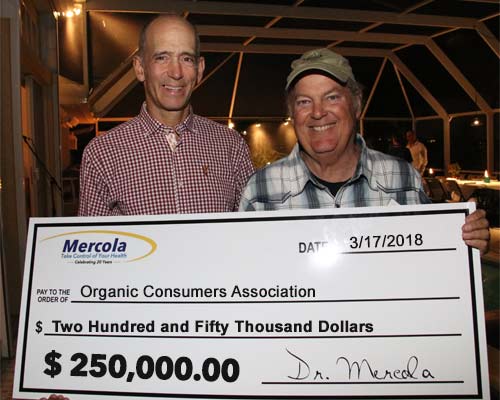Story at-a-glance
- Tyrone Hayes, Ph.D., an integrative biologist at the University of California, Berkeley, has spent a decade feuding with chemical giant Syngenta, manufacturer of the pesticide atrazine
- Novartis, which eventually became Syngenta, asked Hayes to use his extensive knowledge of frog hormones to determine if atrazine was interfering with frogs in the environment
- He found atrazine may be chemically castrating male frogs, essentially turning them into female frogs; Syngenta attempted to discredit Hayes after the damaging research was released
- Levels of another pesticide, glyphosate, significantly correlated with shortened pregnancy lengths in pregnant women
- Meanwhile, potentially catastrophic declines in bird populations in France are also thought to be due to pesticides, which are killing off insects at alarming rates
By Dr. Mercola
Though he still sees himself as “just a little boy who loves frogs,” Tyrone Hayes, Ph.D., an integrative biologist at the University of California, Berkeley, has spent a decade feuding with chemical giant Syngenta, manufacturer of the pesticide atrazine. Novartis, which eventually became Syngenta, asked Hayes to use his extensive knowledge of frog hormones to determine if atrazine was interfering with frogs in the environment.
It certainly wasn’t what they wanted to hear, but he found atrazine may be chemically castrating male frogs, essentially turning them into female frogs. When Hayes reported some of his troubling findings to the U.S. Environmental Protection Agency (EPA), including male frogs with eggs bursting out of their testicles — “I thought they would be interested, after all it was the No. 1 selling chemical in the world at the time,” he said — they stated it wasn’t an adverse effect that would prompt them to reevaluate the chemical.
Hayes resigned his contractor position with Syngenta after the company refused to allow him to publish the results of studies they had funded. After resigning, he obtained independent funding to repeat the research, which was subsequently published and found that atrazine causes hermaphroditism in frogs.
Syngenta attempted to discredit Hayes after the damaging research was released. However, as Hayes argues in the TED talk above, he follows Albert Einstein’s notion that “those who have the privilege to know, have the duty to act.”
Atrazine Shown To Be Harmful to Animals, Humans and the Environment
Hayes’ research hypothesized that atrazine turned on an enzyme (aromatase) that caused testosterone to be converted into estrogen. If you’re a male, this means that you won’t make sperm, but you will make estrogen, even though you shouldn’t.
According to Hayes and colleagues in research published in Nature in 2002, exposure to water-borne atrazine contamination led to “gonadal abnormalities such as retarded development and hermaphroditism” in 10 percent to 92 percent of male wild leopard frogs. Hayes published another study in 2010 in Proceedings of the National Academy of Sciences (PNAS), which similarly found:1
“Atrazine-exposed males suffered from depressed testosterone, decreased breeding gland size, demasculinized/feminized laryngeal development, suppressed mating behavior, reduced spermatogenesis and decreased fertility.”
Yet, if atrazine is harming wildlife via the water supply, it stands to reason that it could harm humans as well. Indeed, Hayes cites research showing that men with higher levels of atrazine in their urine (the same level he and colleagues used to “chemically castrate” frogs — 0.1 parts per billion (ppb)) have lower sperm counts. Other research shows that workers who apply atrazine in agricultural fields have 24,000 times the atrazine level in their urine than was used to chemically castrate frogs.
He soon became involved in environmental justice, as he learned that most of the individuals being exposed to these high levels of atrazine are Latin American or Mexican American. The evidence also suggests atrazine exposure may contribute to a number of different cancers, specifically ovarian cancer, non-Hodgkin's lymphoma, hairy-cell leukemia and thyroid cancer.
In addition, Hayes cited research showing an 8.4-fold increase in prostate cancer in males working in an atrazine factory — in a community that’s 80 percent African-American. Again, racial or ethnic minorities are disproportionately affected.
Atrazine Contaminates Drinking Water
As far as pesticides go, atrazine is the one most commonly found in U.S. drinking water. In 2012, Syngenta AG and its U.S. subsidiary were ordered to pay $105 million to filter the chemical out of Midwestern community water treatment operations providing drinking water to 52 million Americans.2 The legal proceedings revealed that as many as 1 in 6 Americans was drinking atrazine-contaminated water. The $105 million settlement was really just a drop in the bucket when compared to the actual cost of filtering this chemical.
In 2010, the plaintiffs' attorney, Stephen Tillery, said the 16 cities included in the original lawsuit had already spent about $350 million to filter it out. Since 2012, at least 1,085 other compensation claims over atrazine contamination have been filed against Syngenta, suggesting the problem is incredibly widespread.
Also disturbing, studies show a correlation between atrazine in drinking water and breast cancer incidence in Kentucky,3 whereas previous research on rats showed exposure to atrazine increased the incidence of mammary cancer.4
As Hayes pointed out, “This is an interesting problem, because breast cancer … is estrogen dependent and … aromatase … produces the estrogen during breast cancer that stimulates those breast cancers to grow and divide and turn into tumors and spread.” He then points out that the No. 1 treatment for breast cancer is a chemical called Letrozole, which works by knocking out aromatase and decreasing the estrogen that’s fueling the cancer. Hayes explained:
“That drug, though, has to work against the 80 million pounds of atrazine that we’re using every year … that does exactly the opposite. I got in trouble because I pointed out that Novartis Oncology, in the year 2000, offered treatments for cancer, including breast cancer, so the same company that gave us 80 million pounds of this contaminant associated with breast cancer was also selling a chemical that does the opposite to treat breast cancer.”
Glyphosate Also Linked to Reproductive Problems
Atrazine is only one pesticide that’s causing potentially devastating effects on future generations. Glyphosate, the active ingredient in Monsanto’s Roundup, is another. More tons of glyphosate have been sprayed worldwide than any other herbicide before it. In addition to being declared a probable human carcinogen by the International Agency for Research on Cancer (IARC), researchers from Indiana University and University of California San Francisco linked the chemical to earlier deliveries in pregnant women.5
Not only did 90 percent of the pregnant women in the study, who resided in central Indiana, test positive for glyphosate, but the levels significantly correlated with shortened pregnancy lengths.
While Monsanto downplayed the findings, stating they are not indicative of adverse health outcomes,6 the study’s lead author, Shahid Parvez, an assistant professor in the department of environmental health science at Indiana University-Purdue University Indianapolis, stated, "There is growing evidence that even a slight reduction in gestational length can lead to lifelong adverse consequences."7
Glyphosate is used in large quantities on genetically engineered (GE) glyphosate-tolerant crops (i.e., Roundup Ready varieties). Its use actually increased nearly fifteenfold since such GE crops were introduced in 1996.8 Glyphosate is also a popular tool for desiccating (or accelerating the drying out) of crops like wheat and oats. Unbeknownst to many, glyphosate is sprayed onto many crops shortly before harvest, which is why residues have been found in GE and non-GE foods alike.
According to Parvez, “The bad news is that the dietary intake of genetically modified food items and caffeinated beverages is suspected to be the main source of glyphosate intake."9 In fact women in the study with the highest glyphosate levels were those who lived in rural areas and consumed more caffeinated beverages.
Pesticides Lead to Massive Bird Decline in France
Equally unsettling are the growing reports that pesticides are devastating birds and insects worldwide. Conservation biologists in France described a “catastrophic” situation in which dozens of species of birds have declined in the country, some with population cuts up to two-thirds. Research shows, for instance, that once-common birds like the common white throat and the Eurasian skylark have seen their populations fall by at least one-third, whereas the meadow pipit declined by close to 70 percent.10
It’s not that the birds are being directly poisoned to death that’s the problem, but rather that their food supply — insects — is. Vincent Bretagnolle, a National Centre for Scientific Research (CNRS) ecologist at the Centre for Biological Studies in Chize, told The Guardian, “There are hardly any insects left, that’s the No. 1 problem,” adding that past studies have found 80 percent declines in flying insects in Europe in recent years, along with a loss of 400 million birds in the last three decades.11
Declines in certain insect groups like bees, butterflies and even moths have been apparent for some time, according to researchers of a 2017 study published in PLOS One.12 However, their study looked at total flying insect biomass over a period of 27 years in 63 protected areas in Germany to assess the bigger picture, revealing a 76 percent decline in flying insects over a period of 27 years in Germany.
The ramifications of disappearing insects should not be taken lightly. It’s estimated that 80 percent of wild plants depend on insects for pollination, and 60 percent of birds depend on them for food. Further, the “ecosystem services” provided by insects as a whole is estimated at $57 billion annually in the U.S. alone, the researchers noted, so “[c]learly, preserving insect abundance and diversity should constitute a prime conservation priority.”13
New Bayer Pesticide Harms Bees’ Cognition
Neonicotinoid pesticides, which are widely used in intensive agricultural operations, have been implicated in the decline of bees, particularly in commercially bred species like honeybees and bumblebees, although wild foraging bees may be negatively affected also.14 Neonicotinoids are the most widely used insecticides on the planet, though their use was recently restricted by the European Union.
Bayer AG has since released a new pesticide called Sivanto, whose active ingredient, flupyradifurone, binds to the nicotinic acetylcholine receptor (nAchR) in the honeybee brain, as do neonicotinoids. A 2018 study published in Scientific Reports has already revealed that the chemical “can reduce taste and appetitive learning performance in honeybees foraging for pollen and nectar.”15
One of the study’s authors, Hannah Hesselbach, said in a news release, “[A] flupyradifurone amount of 1.2 micrograms per bee results in significantly reduced perception and learning performance … Also, we cannot say which influence flupyradifurone will have on bees in combination with other pesticides which are frequently found in honey and pollen in residual amounts.”16 As Hayes noted, we all have a “duty to act” when it comes to protecting future generations from the harmful effects of this pesticide overload.
Keep in mind that you can help protect the welfare of humans, animals, insects and the environment alike every time you shop organic and grass fed, as you are “voting” for less pesticides and herbicides with every organic and pastured food and consumer product you buy. In addition, take steps to make your own backyard healthier for everyone by eliminating the use of pesticides and other chemicals and planting a diverse variety of native flowers and other plants.
Biotech Companies Are Gaining Power by Taking Over the Government
Monsanto and their industry allies will not willingly surrender their stranglehold on the food supply. They must be resisted and rolled back at every turn. There is no doubt in my mind that GMOs and the chemical-intensive agricultural model of which they are part and parcel, pose a serious threat to the environment and our health. Yet, government agencies not only turn a blind eye to the damage they are inflicting on the planet, but actively work to further the interests of the biotech giants.
This is not surprising. It is well-known that there is a revolving door between regulatory agencies and private corporations. This has allowed companies such Monsanto to manipulate science, defang regulations and even control the free press, all from their commanding position within the halls of government.
Consider for a moment that on paper, the U.S. may have the strictest safety regulations in the world governing new food additives, but has repeatedly allowed GMOs and their accompanying pesticides such as Roundup to circumvent these laws.
In fact, the only legal basis for allowing GE foods to be marketed in the U.S. is the FDA’s tenuous claim that these foods are inherently safe, a claim which is demonstrably false. Documents released as a result of a lawsuit against the FDA reveal that the agency's own scientists warned their superiors about the detrimental risks of GE foods. But their warnings fell on deaf ears.
Don’t Be Duped by Industry Shills!
In a further effort to deceive the public, Monsanto and its cohorts spoon-feed scientists, academics and journalists a diet of questionable studies that depict them in a positive light. By hiring “third-party experts,” biotech companies are able to take information of dubious validity, and present it as independent and authoritative.
Industry front groups also abound. The Genetic Literacy Project and the American Council for Science and Health are both Monsanto-funded. Even WebMD, a website that is often presented as a trustworthy source of "independent and objective" health information, is heavily reliant on advertising dollars. It is no coincidence that they promote corporate-backed health strategies and products.
There’s No Better Time to Act Than NOW — Here’s What You Can Do
The biotech giants have deep pocketbooks and political influence, and are fighting to maintain their position of dominance. It is only because of educated consumers and groups like the Organic Consumers Association (OCA) that their failed GMO experiment is on the ropes. We thank all of the donors who helped OCA achieve their fundraising goal. I made a commitment to triple match all donations to OCA during awareness week. It is with great pleasure to present a check to this fantastic organization for $250,000.

At the end of the day, we must shatter Monsanto’s grip on the agricultural sector. There is no way to recall GMOs once they have been released into the environment. The stakes could not be higher. Will you continue supporting the corrupt, toxic and unsustainable food system that Monsanto and its industry allies are working so hard to protect?
For more and more people, the answer is no. Consumers are rejecting genetically engineered and pesticide laden foods. Another positive trend is that there has been strong growth in the global organic and grass fed sectors. This just proves one thing: We can make a difference if we steadily work toward the same goal.
One of the best things you can do is to buy your foods from a local farmer who runs a small business and uses diverse methods that promote regenerative agriculture. You can also join a community-supported agriculture (CSA) program, where you can buy a “share” of the vegetables produced by the farm, so that you get a regular supply of fresh food. I believe that joining a CSA is a powerful investment not only in your own health, but in that of your local community and economy as well.
In addition, you should also adopt preventive strategies that can help reduce the toxic chemical pollution that assaults your body. I recommend visiting these trustworthy sites for non-GMO food resources in your country as well:
Monsanto and its allies want you to think that they control everything, but they are on the wrong side of history. It’s you, the informed and empowered, who hold the future in your hands. Let’s all work together to topple the biotech industry’s house of cards. Remember — it all starts with shopping smart and making the best food purchases for you and your family.














